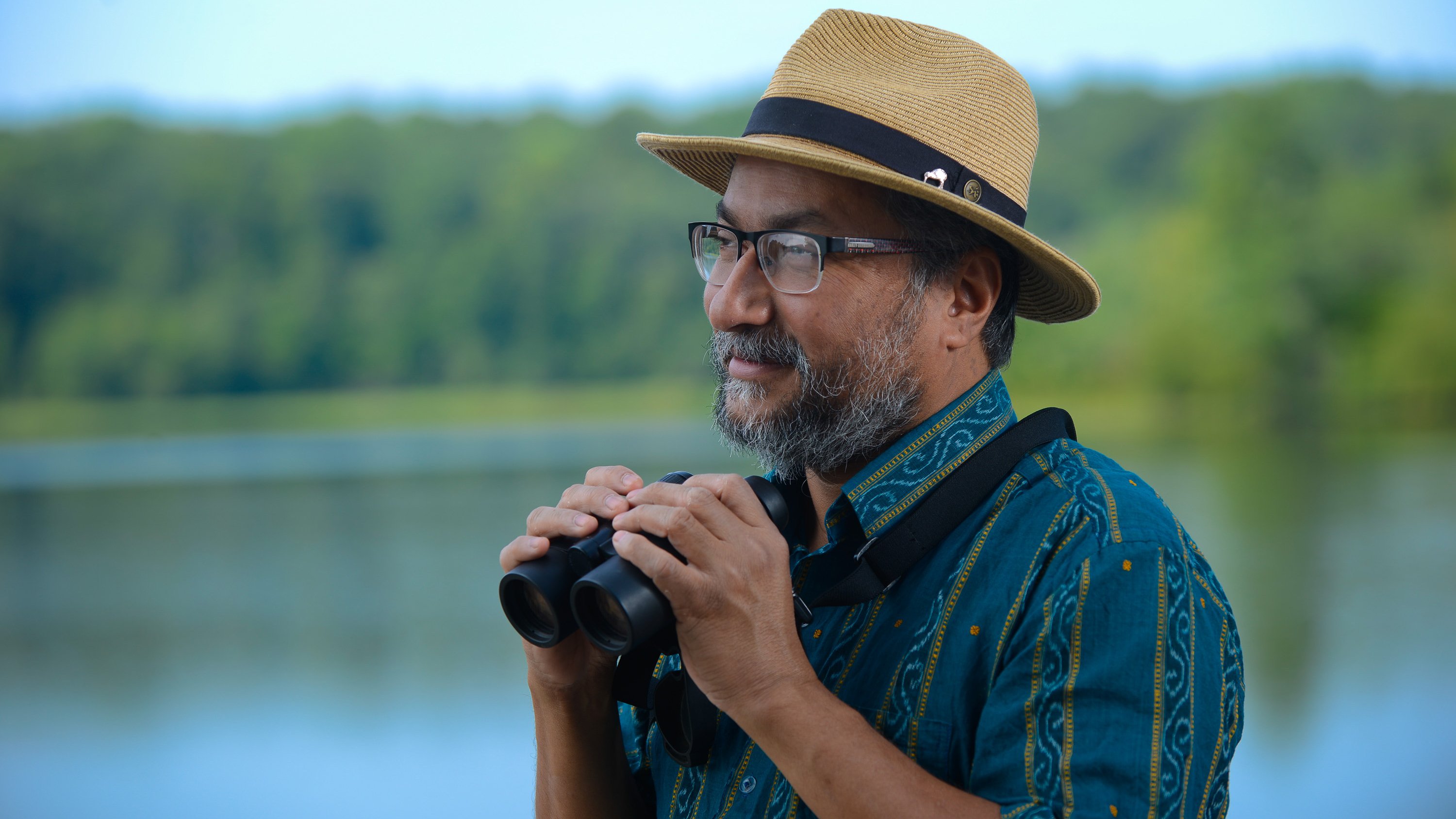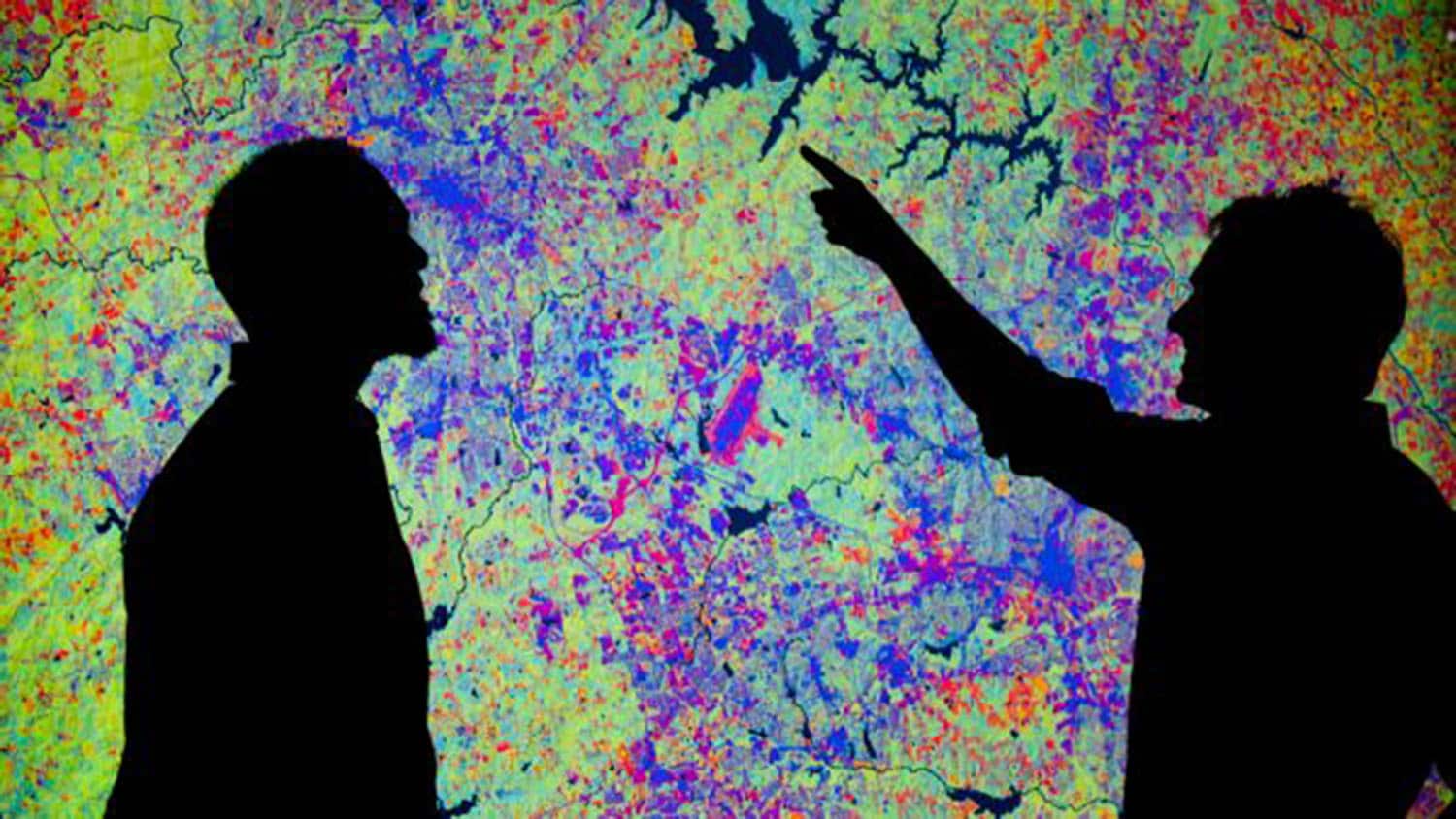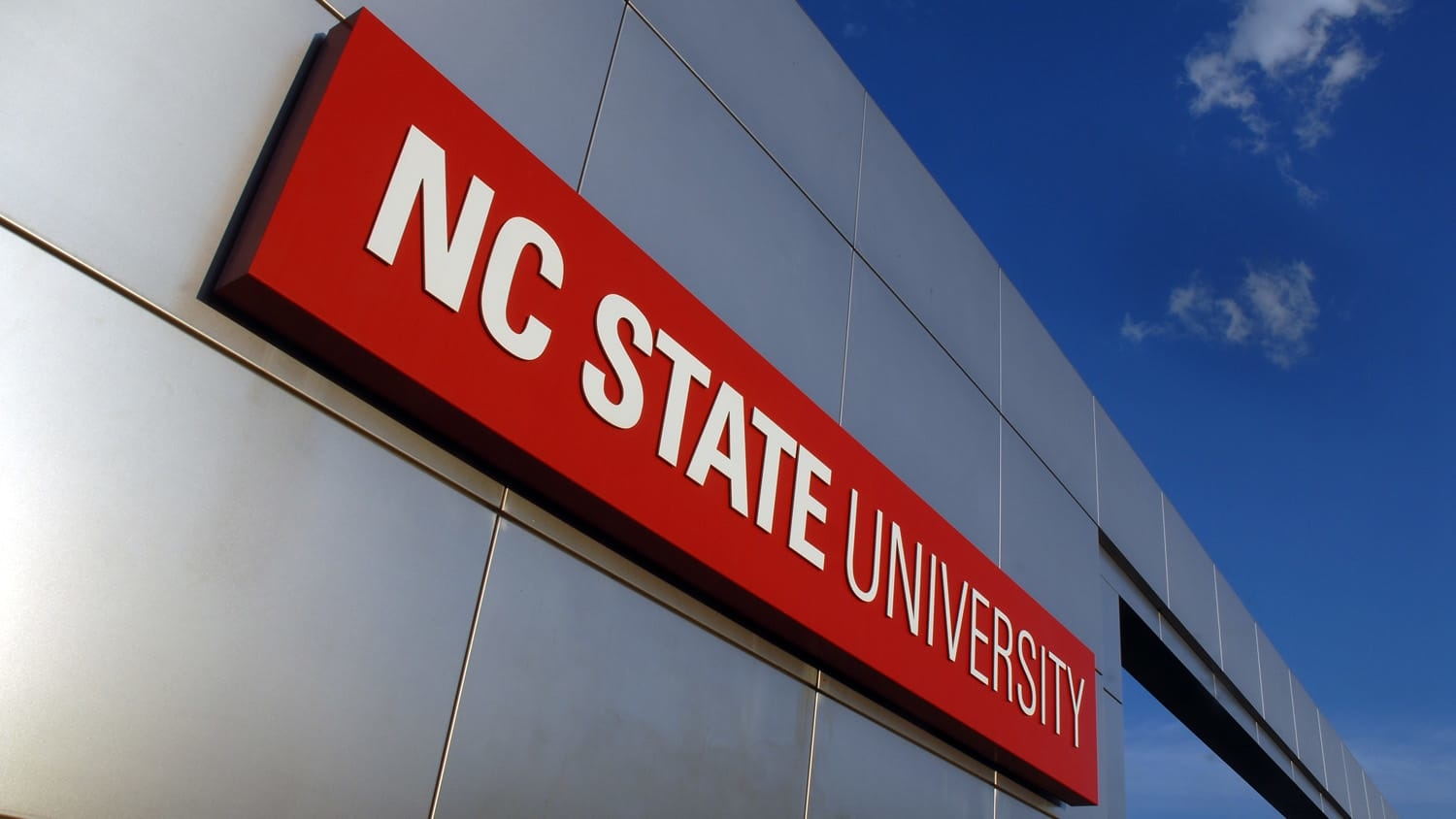This is one in a series of five Q&As with the members of NC State’s Leadership in Public Science faculty cluster. Read more about the cluster.
Madhusudan Katti’s research as an ecologist has taken him from remote mountain wilderness in India to the suburban sprawl of Fresno, California — and his public science efforts are no less diverse, encompassing everything from citizen science projects to his own radio program.
Katti, an associate professor of forestry and environmental resources at NC State, has precisely the suite of skills the university was looking for when it began developing the Leadership in Public Science program, and he has high hopes for engaging North Carolinians in his efforts to understand the wildlife of our cities.
Learn more about Katti and his work.
What does your research focus on?
I study how human activities shape habitats for other species in cities, and how other species respond and adapt to human influences. I use approaches from evolutionary ecology to understand the dynamic interactions between humans and nature in urban contexts and to seek ways to reconcile human development with biodiversity conservation — a field known as reconciliation ecology.
Recognizing cities as complex social-ecological systems, I study how human social, cultural, historic and economic variables interact with underlying geographical and ecological variables to influence the behavior and ecology of animals living in cities. I helped create and play an active role in UrBioNet, a global research network bringing together scientists and practitioners studying and conserving biodiversity in urban ecosystems, funded by the National Science Foundation.
My current research projects in urban ecology range from local-scale studies within particular cities to global-scale comparative studies of cities in different parts of the world. The broad goal is to understand patterns of species distribution and diversity at different geographical scales and identify key mechanisms of how cities transform regional biological diversity. The primary areas of research focus at the moment include the effects of water policies and human perceptions of water availability on residential landscaping choices and, in turn, on urban biodiversity in cities of the American Southwest; the effects of urban traffic noise on the songs of birds; how changes in distribution and availability of food influence the foraging behavior of animals; and uncovering global patterns in urban biodiversity to deepen our understanding of cities in an evolutionary context.
Looking forward, I am particularly keen on addressing gaps in our global knowledge, focusing on tropical and developing countries where we need to build research capacity to address the most urgent and intense challenges of biodiversity conservation in the face of rapid and unregulated urban development that too often leaves both people and nature behind. And I see public science as a key to being able to do this effectively.
I am also beginning to study how humans acquire ecological knowledge in traditional and modern societies and how citizen science can play a role in bolstering our collective ecological knowledge and making it more resilient in the context of rapid global change. Understanding how we transform ecosystems and the lives of other species and the role of ecological knowledge in how we govern our commons is crucial to our collective ability to navigate through what is now called the Anthropocene, as responsible stewards rather than reckless agents of the next mass extinction.
What does “public science” mean to you, and how does it factor into your work?
Public science is about removing barriers and bridging gaps between academic science and the general public. Knowledge of how nature works (scientific knowledge) need not be as inaccessible or esoteric to most people as it has become. We celebrate Galileo for making science accessible to the public of his time by writing about his discoveries in common language. Charles Darwin also wrote directly for the broader public. Indeed, Darwin also actively corresponded with a wide range of people from all backgrounds who were involved in animal and plant breeding, or were simply curious about nature, whose observations helped him develop and test his theory of evolution by natural selection. This might be considered an early example of “crowdsourcing,” an approach now part of the toolkit for what we call citizen science.
Public science encompasses multiple approaches to engage the public in the creation and dissemination of scientific knowledge, ranging from basic science communication to citizen science and crowdsourcing to fully participatory research collaborations between academic scientists and nonacademic publics. This has become necessary because science as an academic practice has become increasingly isolated as scientists buckled down to the nitty-gritty of conducting research in their labs and at their field research sites. Research questions also became narrower as our knowledge of nature deepened, especially given how scientists found it useful to specialize and focus on specific mechanisms of nature.
While this intense focus has led to some incredible breakthroughs in science, it has also alienated some of the very public that enables academic science through taxpayer-funded programs. Science is also perceived to be vulnerable to various cultural, political and economic forces who exploit the lack of public understanding to serve their own vested interests. To address these challenges, especially in the U.S., we scientists must change how we do our work and how we engage with society as trustworthy actors/honest brokers who have something valuable to offer to any healthy democracy.
Meanwhile, our technological advances have also created enormous environmental problems, intertwined in complex ways with how we organize societies and governments in the modern world. We therefore now face a number of “wicked problems,” including the global extinction crisis and climate change, which require urgent solutions that can only be found and developed through collaboration across disciplinary boundaries. Most scientists and funding agencies now recognize the importance of interdisciplinary collaboration for research, but translating science into practical solutions for real-world wicked problems requires us to go beyond our comfort zones to cultivate meaningful and sustained engagement with diverse local and global communities.
Public science answers these challenges through a comprehensive approach to engage the public throughout the cycle of science from asking questions to developing methodologies to gathering and analyzing data to informing policy to applying solutions in real-world contexts. The agenda of public science also includes research on how science is conducted, how knowledge is generated and disseminated, and how scientific solutions are applied to wicked problems in messy real-world situations.
In terms of my own work, engaging the public is critical in urban ecology not just for finding practical solutions to the environmental problems of urbanization, but also for answering the most basic research questions. Not only does urban ecology — the study of complex social-ecological systems — necessarily involve people as part of the study system, but my very access to research sites is in the hands of the public! I therefore use citizen science approaches to obtain data for my research and engage with urban citizens through focus groups and other public conversations.
More broadly, I view public science as a key to urban ecology research because it provides a framework to study the dynamics of complex systems in which people are active participants. This includes a unique opportunity to interrogate a key ecological driver (people) of urban ecosystems. In turn, urban ecology research can also influence how people (the key ecological driver) behave to shape the future dynamics of cities as ecosystems.
What drew you to public science in the first place?
I have always had a fascination for science as the best way to feed my curiosity about nature and people. I became inspired to pursue a career in science not because of what I learned in my school science classroom or laboratory, but through reading books written by public scientists like Rachel Carson, Barry Commoner, Stephen Jay Gould, Carl Sagan and Masanobu Fukoaka. My academic training in ecology and evolutionary biology was therefore also deeply informed by a sense of public responsibility. While the rigors of academia offered few avenues for public engagement, especially for a graduate student, I tried to grab opportunities whenever I could for public speaking, writing for broader audiences and engaging with public officials to inform policy for nature conservation.
After a decade pursuing evolutionary ecology research in relatively remote forests and mountains in India, I jumped into urban ecology as a postdoctoral scholar at the turn of the century. Urban ecology enabled me to collaborate with people from other disciplines, to feed my passion for biology and curiosity about people in nature, and to try to live up to my sense of social responsibility by engaging with the public.
Then I got a faculty position in Fresno, the largest city in the great Central Valley of California, an agriculturally rich but economically depressed region. As a biology professor, I found myself facing students in my evolution class who had difficulty accepting the facts of evolution. As an urban ecologist concerned about sustainability, I was in a city with limited water resources that nevertheless had neither water meters nor restricted water use in any significant way. These circumstances were most directly responsible for drawing me into public science.
I created new citizen science projects, like the Fresno Bird Count, to develop my research program in urban ecology. I was invited to become a regular contributor to a commentary series, “The Moral Is,” on the local public radio station. As an attempt to bring science into Fresno’s public discourse, I started the Central Valley Café Scientifique as a monthly forum that is now in its 10th year. This led to an invitation from another local radio station to create a monthly show on science, which is now also a podcast called “Science: A Candle in the Dark.” I also started blogging to share my perspective on reconciliation ecology with non-academic audiences, and as a tool to teach science writing to my students. This led to further public writing opportunities in widely read forums including The Conversation, The Nature of Cities, Current Conservation and KCET. All of this has now culminated in my becoming part of this cluster for Leadership in Public Science at NC State.
What sort of public science projects are you working on right now?
My public science projects span a range from participatory citizen science in urban ecology and conservation to science communication through writing and podcasts. Based on the model of the Fresno Bird Count, I am now developing a Raleigh/Triangle Bird Count (to launch in the coming year), as well as other urban nature-focused projects for the Wolfpack Citizen Science Challenge at NC State. I am developing similar projects in India, which also involves capacity building for public science and urban ecology, including a collaboration with the Urban Slender Loris Project in Bangalore and colleagues working in other cities in India. On the science communication side, I am preparing to reboot “Science: A Candle in the Dark” as a standalone podcast for local and global audiences. I also continue to write for public audiences on my blog and through other venues.
In terms of new projects, I am exploring two new directions: developing a public archive for oral histories of urban nature, building on interviews with long-term residents of Bangalore through the Urban Slender Loris Project; and studying the process of how people acquire ecological knowledge as part of traditional knowledge systems and why such knowledge often declines in a changing world, and finding ways for public science to replenish this knowledge bank by bridging the gap between traditional and academic science knowledge systems. I am also beginning collaborative work in Prague, including research and a study abroad course on comparative urban ecology that I plan to teach starting next summer.
- Categories:



